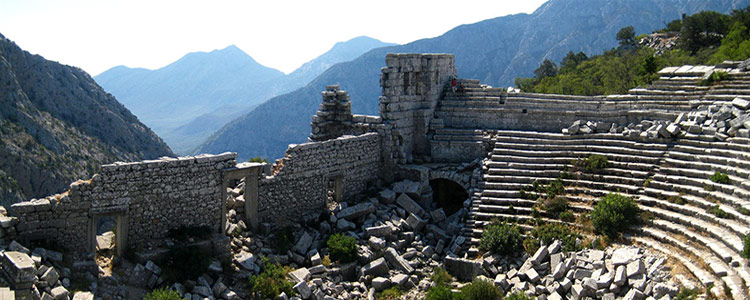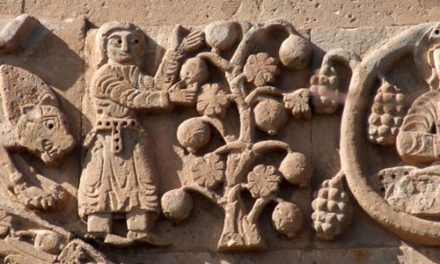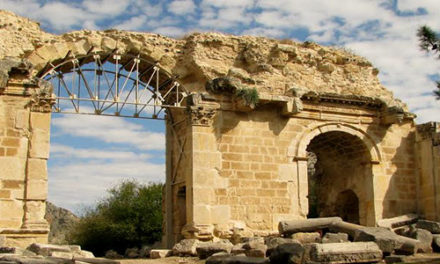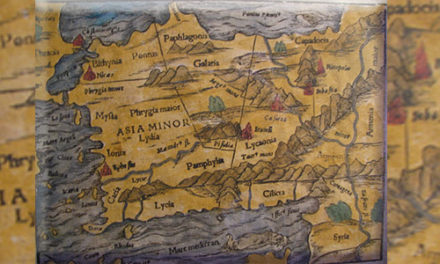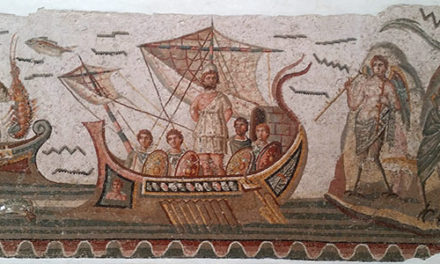Pamphylia (Παμφυλία)
Location: Southern Anatolia
Nation: Pamphylians, Pisidians, Greeks
Historical capitals: Perge
Roman province: Pamphylia
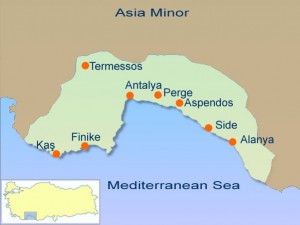 In ancient geography, Pamphylia was the region in the south of Asia Minor, between Lycia and Cilicia, extending from the Mediterranean to Mount Taurus (modern day Antalya province, Turkey). It was bounded on the north by Pisidia and was therefore a country of small extent, having a coast-line of only about 75 miles with a breadth of about
In ancient geography, Pamphylia was the region in the south of Asia Minor, between Lycia and Cilicia, extending from the Mediterranean to Mount Taurus (modern day Antalya province, Turkey). It was bounded on the north by Pisidia and was therefore a country of small extent, having a coast-line of only about 75 miles with a breadth of about
30 miles. Under the Roman administration the term Pamphylia was extended so as to include Pisidia and the whole tract up to the frontiers of Phrygia and Lycaonia, and in this wider sense it is employed by Ptolemy.
The name /Pamphylia/ means literally ‘all tribes’ (/pan/ ‘all’ + /phylē/ ‘tribe’), scil. ‘of Dorians’, who colonized it. There is a legendary character (Pamphylos, son of Aigimios) who personified this.
There can be little doubt that the Pamphylians and Pisidians were the same people, though the former had received colonies from Greece and other lands, and from this cause, combined with the greater fertility of their territory, had become more civilized than their neighbours in the interior. But the distinction between the two seems to have been established at an early period. Herodotus, who does not mention the Pisidians,
enumerates the Pamphylians among the nations of Asia Minor, while Ephorus mentions them both, correctly including the one among the nations on the coast, the other among those of the interior.
The early Pamphylians, like the Lycians, had an alphabet of their own, partly Greek, partly “Asianic,” which a few inscriptions on marble and coins preserve. The legend related by Herodotus and Strabo, which ascribed the origin of the Pamphylians to a colony led into their country by Amphilochus and Calchas after the Trojan War, is merely a characteristic myth. Probably the Pamphylians were of Asiatic origin and mixed ethnicity.
The region of Pamphylia first enters history in Hittite documents. In a treaty between the Hittite Great King Tudhaliya IV and his vassal, the king of Tarhuntassa, we read of the city “Parha” (Perge), and the “Kastaraya River” (Classical Kestros River, Turkish Aksu Çayı).
The first historical mention of “Pamphylians” is among the group of nations subdued by the Mermnad kings of Lydia; they afterwards passed in succession under the dominion of the Persian and Hellenistic monarchs. After the defeat of Antiochus III in 190 BC they were included among the provinces annexed by the Romans to the dominions of Eumenes of Pergamum; but somewhat later they joined with the Pisidians and Cilicians in piratical ravages, and Side became the chief centre and slave mart of these freebooters. Pamphylia was for a short time included in the dominions of Amyntas, king of Galatia, but after his death lapsed into a district of a Roman province. The Pamphilians became largely hellenized in Roman times, and have left magnificent memorials of their civilization at Perga, Aspendos and Side.
As of 1911 the district was largely peopled with recent settlers from Greece, Crete and the Balkans, a situation which changed considerably as a result of the disruptions attendant on the fall of the Ottoman Empire and the war between Greece and Turkey in the 1920s.
List of Pamphylians
* Diodorus of Aspendos Pythagorean philosopher (4th c.BC)
* Apollonius of Perga astronomer, mathematician (ca. 262 BC–ca. 190 BC)
* Artemidorus of Perga proxenos in Oropos (ca. 240-180 BC)
* Aetos (son of Apollonius) from Aspendos ,Ptolemaic commander,founder of Arsinoe (Cilicia)(~238 BC)
* Mnaseas (son of Artemon) from Side (sculptor) end 3rd BC
* Orestas (son of Erymneus) from Aspendos proxenos in Dreros (Crete) (end 3rd-beg. 2nd BC)
* Thymilus of Aspendos, stadion race Olympics 176 BC
* Apollonios (son of Koiranos) proxenos in Lappa (Crete)(1st half 2nd BC)
* Asclepiades (son of Myron) from Perga physician honoured by the demos of Seleucia (Pamphylia)
* Menodora (daughter of Megacles) from Sillyon magistrate and benefactor (ca.2nd c. AD)
* Apollonius of Aspendos poet (2nd/early 3rd c. AD)
* Saint Matrona of Perge (late 5th, early 6th c.AD)
Archaeological sites
* Antalya
* Perga
* Side
* Sillyon
* Eurymedon Bridge at Aspendos, a Roman bridge which was reconstructed by the Seljuks and follows a zigzag course over the river
* Eurymedon Bridge at Selge, a Roman bridge

